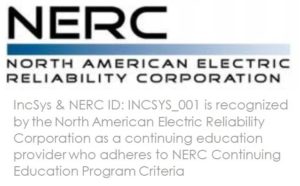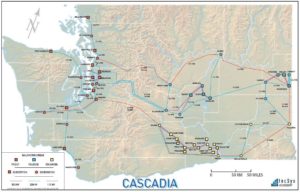 Power Transfer Distribution Factors
Power Transfer Distribution Factors
Course NERC Continued Educational Hours: OT: 2; Stand: 0; SIM: 1.5
This is a NERC Continued Educational computer-based training module which consists of a video lecture and a simulation exercise. Students watch a video lecture covering parallel path flows where they will learn about how megawatts flow along parallel paths. They will also learn how to calculate power transfer distribution factors (PTDF), and the elements that affect PTDFs. Students learn how changing MW flow can help mitigate overloaded transmissions. Students perform a simulated exercise on a hypothetical power system that teaches about PTDFs, LODFs, and controlling MW flows. Students use the hypothetical power system to build equivalent line 230kV line lengths along the major transmission lines, loops, transformers, and sets of multiple parallel lines. The equivalent line lengths are then used to calculate PTDFs for a generation shift to alleviate overloaded transmission lines following various line outage contingencies.
Cascadia 4030 – Course Objectives
Power Transfer Distribution Factors
- Describe how MWs Flow on parallel paths.
- Define Power Transfer Distribution Factors (PTDFs).
- Describe factors that do not affect PTDFs.
- Describe factors that do change PTDFs.
- Describe methods for calculating PTDFs.
- Identify cases where opening a lower voltage path may remove an overload situation.
- Derive an electrical distance diagram where the lines are based on equivalent 230kV lines.
- Apply serial and parallel path reductions to the electrical distance diagrams with measured factors by running the Powersimulator.
- Explain the differences between the predicted and measured PTDFs using he concept of minor loop flows.
- Derive an electrical distance diagram where the line lengths are based on equivalent kV lines.
- Apply serial and parallel path reductions to the electrical distance diagrams to calculate power transfer distribution factors on different paths.
- Compare power transfer distribution factors calculated using the electrical distance programs with measured factors by running the Powersimulator.
- Explain the difference between the predicted and measured PTDFs using the concept of minor loop flows.
Downloadable 4030 Course Flyer
Subject Matter Expert
This course listed is a NERC CE approved continuing education course which will help you obtain the required NERC CE Credit Hours for maintaining the validity of your NERC Certification.
End of Course Instructions
After successful completion of the course the certificate of completion will be available for download and print from your training homepage.
After successful completion of this course your credits will be automatically reported for NERC CE Credits via the NERC SOCCED reporting tool. IncSys Academy also has a policy where credits will be manually reported via SOCCED on a WEEKLY basis (every Monday). It is critical that each candidate provide IncSys Academy with their proper credentials to ensure that proper credits are reported to your SOCCED account. Please contact our team at 425.732.2377 X 3 or via email at calvin.kaiser@incsys.com to report any NERC CE credit items needed for resolution.
Quiz & Simulation Information
There are quizzes and simulation exercises in this course module which must be passed with a MINIMUM grade of 75% to complete the course. Please check your grade report to ensure that you have achieved a passing grade of at least a 75% for each graded area.
IncSys Non-Refundable Policy
Clients who purchase training from the IncSys Academy catalog portal are Non-Refundable from the date of payment. Please ensure that you copy and save your receipt order prior to closing out your purchase order payment.
